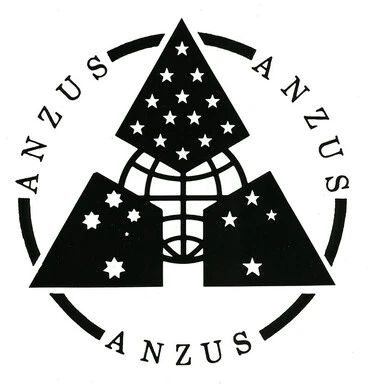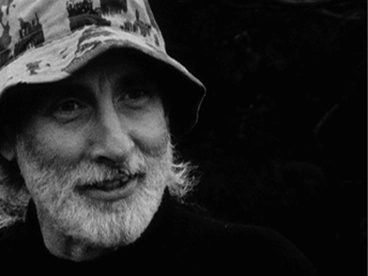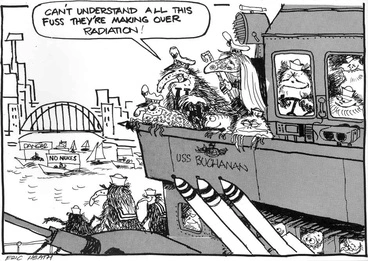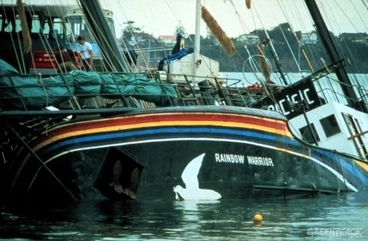Hiroshima & Nagasaki & the anti-nuclear movement
A DigitalNZ Story by Zokoroa
Atomic bombing of Hiroshima & Nagasaki on 6th & 9th August 1945 & the anti-nuclear movement
Hiroshima, Nagasaki, Atomic bomb, Nuclear, World War II, J-Force, Jay Force, Japan, Peace movements, Anti-nuclear, Nuclear-free, Protests, Demonstrations, Treaties
During World War II, the Americans detonated an uranium atomic bomb "Little Boy" over Hiroshima (6 August 1945), followed by a plutonium atomic bomb "Fat Man" over Nagasaki (9 August 1945). The explosions killed tens of thousands of people, including those who were killed by the initial detonation, or later died from their injuries or from radiation poisoning. The majority of the buildings within a 2.4 km radius in Hiroshima and within a 0.8 km radius in Nagasaki were destroyed. The Japanese surrendered six days later on 15 August 1945.
The bombings polarised views worldwide on the ethical, legal, and military justification for the United States to have used the atomic bombs, which gave rise to anti-nuclear protest movements. Commemorative events are held each year in NZ, Japan and other countries, to mark the anniversary of the atomic bombings, coupled with the anti-nuclear messages of "No more Hiroshimas" and "Remember Hiroshima & Nagasaki".
During WWII, US detonated atom bombs "Little Boy" over Hiroshima on 6 Aug 1945 & "Fat Boy" over Nagasaki on 9 Aug 1945
Six days later Japan surrendered on 15 August 1945
Manatū Taonga, the Ministry for Culture and Heritage
The explosions killed tens of thousands & almost all the buildings were flattened within 1 mile radius
Alexander Turnbull Library
Japan surrendered on 15 Aug 1945 & NZ's J-Force joined British Commonwealth Occupation Force to aid US with peacekeeping
Waves of J-Force men & women served between March 1946 - early 1949 on security patrols, medical help & debris clearing
Air Force Museum of New Zealand
Polarised views on ethical, legal & military justifications for the nuclear bombing lead to the anti-nuclear movement
(Photo: Silent peace march on Hiroshima Day, Lambton Quay, Wellington, 1987)
Alexander Turnbull Library
Commemorations in NZ
In 1947, first Hiroshima Day was held in NZ. (Image: Anti-nuclear campaigners in Auckland, 1961)
Auckland Libraries
Peace march "No more Hiroshimas' in Auckland, ca. 1969
(No More Hiroshimas)
Auckland Art Gallery Toi o Tāmaki
Hiroshima Day, Queen Street, 1983
Hiroshima Day, Queen Street
Auckland War Memorial Museum Tāmaki Paenga Hira
Poster advertising Hiroshima Nagasaki candle-light march, ca. 1984
Hiroshima Nagasaki
Auckland War Memorial Museum Tāmaki Paenga Hira
Commemorations in Japan
Peace Memorial Park in Hiroshima is dedicated to those killed by the bomb
Museum of New Zealand Te Papa Tongarewa
Peace Memorial Park sculpture
Japan series: Peace Park sculpture
Museum of New Zealand Te Papa Tongarewa
Folded paper offerings carrying prayers at Peace Memorial Park
Hiroshima's Peace Park - folded paper offerings carrying prayers for victims of the 1945 atomic bomb (Japan)
Museum of New Zealand Te Papa Tongarewa
In Dec 1966, Genbaku Dome registered as World Cultural Heritage Site as a building conveying nuclear damage
Military Service, World War II; Japan; Hiroshima.
Upper Hutt City Library
Barack Obama, the 1st serving US President to visit Hiroshima, laid a wreath at the Peace Memorial Park, 27 May 2016
Obama pays tribute to Hiroshima dead
Radio New Zealand
Bells tolled in Hiroshima as the city marked the 77th anniversary, 2022
Hiroshima prays for peace, fears new arms race on atomic bombing anniversary
Radio New Zealand
The following summarises:
1. Atomic bombs "Little Boy" & "Fat Man"
2. NZ's J-Force joins occupation force in Japan, 1946-1949
3. Bombings cause reverberations around world
4. Post-WWII: Treaties & development of nuclear weapons
5. Anti-nuclear movements & nuclear-free zones
6. NZ & Japan commemorations: "Remember Hiroshima & Nagasaki"
>>>>>>>>>>>>>>>>>>>>>>>>>>>>>>
1. Atomic bombs "Little Boy" & "Fat Man"
After outbreak of WWII when Germany invaded Poland on 1 Sept 1939, UK & US began their own nuclear research programmes
Auckland Libraries
UK began research in 1939 & formed MAUD Committee (1940) which began "Tube Alloys" project in 1941 with Canada
MAUD Committee shared research with US 'Manhattan Project' which was formed in 1942 under Major General Leslie Groves
National Library of New Zealand
On 14 Aug 1943, during Allied conference at Quebec, secret agreement signed by US & UK to coordinate nuclear research
From 19 Aug 1943, UK & US collaborated under Manhattan Project & formed Combined Policy Committee (Canada became member)
National Library of New Zealand
Scientist J. Robert Oppenheimer was director of Los Alamos Laboratory that tested 1st bomb on 16 July 1945 at New Mexico
Article describes testing of 1st bomb (implosion-design plutonium device named "Gadget") by dropping from a steel tower
National Library of New Zealand
The next two bombs were built, the first using uranium-253 (named "Little Boy") & the second using plutonium ("Big Boy")
Photos (Left) Testing of "Gadget" at 'Trinity' site in New Mexico. Photo (Right) "Little Boy" bomb dropped on Hiroshima.
Auckland Libraries
Dr Williams (NZ DSIR) was involved with separating nuclear fuel from natural uranium for use in "Little Boy" bomb
In 1944, NZ DSIR staff were assigned to nuclear research team at UK DSIR, then to Univ of California, & Montreal
Radio New Zealand
Article summarises research by scientists after New Zealander Lord Rutherford explored hydrogen atom in 1919
National Library of New Zealand
Why bombs dropped on Japan:
Japan entered WWII with attack on Pearl Harbor on 7 Dec 1941, followed by attacks in Central Pacific & SE Asia
After Germany surrendered on 7 May 1945, the Allies focused on the war with Japan
Auckland Libraries
From mid-1944, US began high-altitude precision bombing over Japan which targeted industries & transportation networks
Results were mixed due to distance from airbases (Chengdu & Mariana), weather & technical issues, & enemy counteraction
National Library of New Zealand
Between Jan-June 1945, US changed tactics to low-level incendiary raids against war industries in Japan's cities & towns
This resulted in the fire-bombing of the 6 main cities, followed by over 90 smaller cities and towns
Auckland Libraries
After the successful testing of "Gadget", the Potsdam Declaration was issued to Japan on 26 July 1945 to surrender
US President Truman, British PM Churchill & China's Chairman Chiang Kai-shek prepared the document at Potsdam Conference
National Library of New Zealand
The Declaration outlined unconditional terms of surrender or face "prompt and utter destruction"
US bombers dropped over 3 million leaflets on the Declaration over Japan
National Library of New Zealand
Flyers were also prepared to be given to surrendering troops to hand to an Allied forces Commanding Officer
Alexander Turnbull Library
Radio Tokyo (Tokio) reported the Japanese Cabinet met at 5pm on 26 July & chose to ignore the ultimatum to surrender
National Library of New Zealand
When Japan did not respond within the next ten days, the US dropped the atomic bomb on Hiroshima on 6 August 1945
(Article speculates on possible reactions of the Japanese leaders on receiving the Declaration)
National Library of New Zealand
>>>>>>>>>>>>>>>>>>>>>>>>>>>>>
TARGETS: Hiroshima & Nagasaki (Replaced KOKURA):
Hiroshima was selected as the primary target (codenamed Operation Centerboard I) for the first nuclear bomb as the city was the headquarters of the Japanese Second Army and a strategic port. The second target (codenamed Operation Centerboard II) was Kokura on the northern tip of Kyushu Island. Kokura was chosen as it held one of Japan's largest military arsenals, which produced chemical and conventional weapons. However, as thick clouds and haze prevented the bombardier from sighting the designated drop zone at Kokura, the bomber proceeded to its secondary target, the port city of Nagasaki.
Hiroshima lies on SW coast of Japan's main island of Honshu & Nagsaki on the NW coast of the island of Kyushu
Second target was intended to be Kokura, but thick clouds & haze prevented bombardier sighting the drop zone
Manatū Taonga, the Ministry for Culture and Heritage
Hiroshima:
Hiroshima is sited on low, flat ground near the Seto Inland Sea into which the Ōta River flows
The bomb exploded c.600 metres above ground & had a blast radius of c.2.4 kms over flat terrain of city's centre
Kete Horowhenua
Photo was taken 3 minutes after the uranium bomb "Little Boy" had exploded over Hiroshima at 8.15am on 6 Aug 1945
The uranium bomb had explosive yield equal to 12,500 tons of TNT. Dense smoke still blanketed the city 4 hrs later.
National Library of New Zealand
Over 60,000 of 90,000 buildings were destroyed or severely damaged
Fires spread across 11 square kms. (Photo: Tangle of steel where a large industrial building stood)
National Library of New Zealand
Small number (c.50) heavily reinforced concrete buildings designed to withstand earthquakes were partially destroyed
Auckland War Memorial Museum Tāmaki Paenga Hira
The Genbaku Dome was located c.160 metres from bomb’s hypocentre (i.e. directly below the exploding bomb)
The building, which was constructed in 1915, was used to research, design, exhibit & sell products
Alexander Turnbull Library
View across the Ōta River towards the Genbaku Dome in Hiroshima, c.1947
Air Force Museum of New Zealand
Another view of the damage & buildings which withstood the blast
Upper Hutt City Library
Photo (top right): View of crystallised sand following the atomic blast
Auckland Libraries
Article (11 Aug 1945): Japanese soldier described what he had seen during and after the bomb detonated over Hiroshima
National Library of New Zealand
View of damaged buildings and dead trees in a street in Hiroshima, c.1947
Air Force Museum of New Zealand
NZ On Screen (2016: 37:40 min): “Memories of Service 2 - James Murray": Reflects on seeing bomb explode over Hiroshima
NZ On Screen
RNZ (21 June 2019: 11:41 min): Taeko Yoshioka Braid recounts her experiences of surviving Hiroshima when aged 13
(Later on, she married a NZ soldier stationed in Japan & they moved to Hastings)
Radio New Zealand
Nagasaki:
Nagasaki lies on a harbour surrounded by hills & mountain spurs
The bomb was donated in the Urakami Valley to the northwest of the city centre & terrain reduced radius to 0.8 kms
Auckland Libraries
Article (13 Aug 1945): US military recount the flight to drop the bomb "Fat Man" over Nagasaki on 9 Aug 1945 at 11.02am
National Library of New Zealand
Article (10 Sept 1945): Observer aboard one of the two SuperFortresses accompanying the plane that dropped the bomb
National Library of New Zealand
RNZ (10 Aug 2015: 23:22 min): Interview with Susan Southard about her retelling of 5 teenage survivors at Nagasaki
Southard had written the book "Nagasaki: Life After Nuclear War"
Radio New Zealand
Casualities at Hiroshima & Nagasaki:
The explosions killed an estimated 110,000 to 210,000 people by the end of 1945, including those who were killed by the initial detonation, or later died from their injuries or from radiation poisoning. (Accurate figures were not able to be obtained as the Japanese did not record the census data of each city's population; official records were lost when buildings were destroyed (hospital, fire, police and government departments); the number of transient workers was not known; burial records were incomplete; and not all the bodies buried in the ruins or caught in the fires that broke out were recovered.)
Source: Alex Wellersten (4 Aug 2020), "Counting the dead at Hiroshima and Nagasaki', Bulletin of the Atomic Scientist
Article (6 Sept 1945): Survivors at Hiroshima were still dying at rate of 100 a day from burns & infections
National Library of New Zealand
An estimated 110,000 to 210,000 deaths occurred by end of 1945, with the varied estimates due to insufficient data
(Census data was not kept, number transient workers unknown, not all bodies recovered & burial records were incomplete)
National Library of New Zealand
Casualties included Koreans conscripted during WWII by Japan who had ruled Korea since 1910
c.670,00 Koreans worked in military, factories & mines in Japan. Estimates of bomb casualties vary from 5,000-50,000.
Alexander Turnbull Library
Casualty figures included those who died directly after the bombing & from injuries & radiation exposure afterwards
Article (25 Aug 1945) describes the effect that the radiation had on those within 2 miles (3.2 kms) of the bomb blast
National Library of New Zealand
2. NZ's J-FORCE joins occupation force in JAPAN, 1946 - 1949
After the Japanese surrendered to the Allies on 15 August 1945, the British Commonwealth Occupation Force (BCOF) was formed to support the United States occupation of Japan. The BCOF included personnel from Britain, Australia, India and New Zealand. The intent was to demilitarise Japan, restore peace and security, and support the social, economic and political rebuilding of Japan.
On 21 August 1945, the NZ Government agreed to provide one fighter squadron and an army contingent to the BCOF. It established the 'Second New Zealand Expeditionary Force (2NZEF), Japan' which became known as the J-Force (or Jay Force or Japan Force). Great Britain and India withdrew from the BCOF in 1947, and NZ decided in April 1948 to also withdraw which was implemented by early 1949. More than 12,000 New Zealanders served in the J-Force. Fifteen died in Japan and are buried in the Commonwealth cemetery at Yokohama. The United States continued to occupy Japan until the Peace Treaty, which was signed with Japan on 8 September 1951, came into force on 28 April 1952.
Find out more: Simon Moody, "Occupying Japan: the RNZAF and J-Force 1946-1948", Air Force Museum of New Zealand: Part 1: 7 March 2021 and Part 2: 2 November 2021
The Japanese surrendered on 15 August 1945, & peace celebrations were held in NZ
Auckland Libraries
After the Japanese surrendered, the U.S. & allies occupied Japan
Trove
On 21 Aug 1945, NZ Govt agreed to join British Commonwealth Occupation Force (BCOF) with Britain, Australia & India
NZ agreed to provide one fighter squadron & an army contingent
Air Force Museum of New Zealand
NZ formed the 'Second New Zealand Expeditionary Force (2NZEF), Japan' which became known as J-Force (& Jayforce)
J-Force comprised aircrew from former No.488 Squadron & army contingent initially from 2NZEF due to return from Italy
Auckland Libraries
Recruitment of fighter squadron:
The fighter squadron, No. 14 Squadron, was formed with 24 aircrew and 250 support staff from the No. 488 Squadron that had fought in Malaya and Singapore against the Japanese during 1941-1942 and returned to NZ in 1942.
On 7 March 1946, J-Force's fighting squadron, named No. 14 Squadron, paraded along Queen Street before leaving for Japan
The 24 aircrew & 250 support staff were from No. 488 Squadron who'd fought in Malaya & Singapore campaign, 1941-42
Air Force Museum of New Zealand
Also loaded aboard the HMS Glory were 24 FG-1D Corsairs, transport vehicles & supplies
The Corsairs were selected from the storage depot at Rukuhia & flown to Hobsonville for servicing & repainting
Auckland Libraries
Recruitment of J-Force army contingent:
As the 2NZEF were about to return from Italy to NZ, the initial J-Force army contingent was drafted from its 9th Infantry Brigade Group until a special occupation force could be assembled from within NZ. The 9th Infantry Brigade Group consisted of two battalions (22nd and 27th), the 2nd Divisional Cavalry Regiment, the 25th Field Battery, and the 5th Engineer Company. Support units included signals, transport, workshops and medical units. The 22nd and 27th Battalions were redesignated as J-Force's 2nd and 3rd Battalion respectively.
Also included in the initial contingent that left Italy for Japan were 37 women from the New Zealand Army Nursing Service (NZANS) and 36 Women's Army Auxiliary Corps personnel (WAACs) who'd been posted in October 1945 to a newly formed medical unit in Florence, No. 6 New Zealand General Hospital (6NZGH).
The Italy draft, which arrived at Kure Port in Japan on 19 March 1946, was followed by the recruitment in NZ of four relief drafts of returned servicemen and volunteers between May 1946 and September 1948.
Find out more: Wikipedia: 9th Brigade (New Zealand)
On 19 March 1946, the J-Force army contingent drafted from 2NZEF arrived at Kure Port from Italy aboard MS Strathmore
Contingent was drafted from 2NZEF's 9th Infantry Brigade Group's battalions & support units
Air Force Museum of New Zealand
HMS Strathmore included 37 women from New Zealand Army Nursing Service (NZANS) & 36 Women's Army Auxiliary Corps (WAACS)
They'd been posted in Oct 1945 to a newly formed medical unit in Florence, No. 6 New Zealand General Hospital (6NZGH)
Auckland Libraries
After the Italy draft, there were 4 relief drafts of ex-servicemen & volunteers recruited in NZ (March 1946-Sept 1948)
Recruitment poster "Our ocean and our job. Volunteer now for the Occupation Force for Japan" [ca. 1946]
Alexander Turnbull Library
Photo: J-Force soldiers about to depart Japan to return to NZ after being relieved by next wave of J-Force troops
Alexander Turnbull Library
J-Force replacement draft enters camp, 12 March 1947
Christchurch City Libraries
Photo: Three servicemen from one of the relief drafts at Kure, c.1947
Air Force Museum of New Zealand
RNZAF No. 14 Squadron in Japan:
No. 14 Squadron was stationed at Iwakuni in southern Honshu
The airfield had been heavily attacked during WWII and the runway needed to be made operational
Alexander Turnbull Library
The Squadron patrolled looking for any sign of insurgency, illicit fuel or weapon dumps, & smuggling from Korea
Alexander Turnbull Library
The aircrew would turn back Korean boat people attempting to land in Japan
Koreans were seeking a better life than in Korea & some were also involved in the blackmarket trading goods
Alexander Turnbull Library
Itazuke Air Base (nowadays Fukuoka Airport) was also used by the Americans to conduct patrols between Japan & Korea
The former No.2 Osaka Airport was also used by the Americans who renamed it the Itami Air Base (nowadays Osaka Airport)
Air Force Museum of New Zealand
J-Force Army contingent in Japan:
J-Force army was initially deployed in Yamaguchi on southern tip of the main island of Honshu, & nearby Eta Jima Island
Alexander Turnbull Library
The J-Force barracks were readied by Japanese labourers under the supervision of an advanced party
Alexander Turnbull Library
Another view of J-Force barracks at Yamaguchi
Alexander Turnbull Library
Photo: J-Force personnel being greeted at the first confirmation service for troops conducted by Rt Rev J C Mann
Alexander Turnbull Library
Japanese women were employed as housekeepers at the J-Force's military camp
Photo: Two Japanese housegirls employees, Dec 1946
Trove
J-Force barracks fire engine
Alexander Turnbull Library
Sports stadium used by J-Force at Yamaguchi
Alexander Turnbull Library
New barracks were also constructed for J-Force at Ozuki, about 7 miles from Chofu
Alexander Turnbull Library
The Ozuki airfield had been attacked during WWII & plane wreckage lay alongside bomb craters in the runway
Air Force Museum of New Zealand
Supplies:
Supplies were delivered by ship & by Dakota planes flown by RNZAF's No. 41 (Transport) Squadron
No. 41 Squadron operated between Feb 1946 - April 1948 & flew weekly between Whenuapai & Iwakuni airfield
Alexander Turnbull Library
Stores were also provided by the New Zealand Patriotic Fund Board
Alexander Turnbull Library
RNZAF staff bargaining with a Japanese fruiterer at Kure market
Alexander Turnbull Library
J-Force roles:
Following the surrender of Japan, the Koreans were emancipated from being under Japan's rule since 1910
During WWII, c.750,000 Koreans were conscripted into the military, mines & factories, including Hiroshima & Nagasaki
Alexander Turnbull Library
J-Force were involved with repatriating Koreans home
Alexander Turnbull Library
Korean repatriates being innoculated against typhoid fever
Alexander Turnbull Library
Korean repatriates about to embark, Senzaki, Japan
Alexander Turnbull Library
By Dec 1946, the Allies repatriated c.1 million Koreans, Taiwanese, Chinese & SE Asians to their countries of origin
Alexander Turnbull Library
Repatriation operations included checking for smuggling
Alexander Turnbull Library
J-Force roles included repatriating c.3000 Japanese soldiers returning from overseas who arrived at the port of Senzaki
Alexander Turnbull Library
Military staff were appointed as guards at Japanese Prisoner of War (POWS) camps
(Photo: First New Zealanders to arrive in Japan from Wellington aboard a naval ship to guard the POWS)
Alexander Turnbull Library
Patrols looked for military equipment & weapons
(Photo: Patrol on island of Mi-shima which had a radar station & wireless station)
Alexander Turnbull Library
NZ soldiers supervised Japanese customs officers
Alexander Turnbull Library
Guards were placed outside the British Military Court where civilians charged with offences against occupational troops
Alexander Turnbull Library
Troops helped civilians clear debris & rebuild their own homes, some from waste wood & sheet iron
Alexander Turnbull Library
View of a burnt out tram and damaged buildings in Hiroshima, 1947
Air Force Museum of New Zealand
View of main street and tramlines at Hiroshima
Alexander Turnbull Library
Queue waiting for tram at Hiroshima
Alexander Turnbull Library
J-Force interactions with residents & their children led to instances of friendly gestures
Photo: J-force personnel with a turtle given to him by children
Alexander Turnbull Library
New Zealand J Force soldiers hosting a Christmas party for Japanese children, Chofu, Japan
Alexander Turnbull Library
New Zealander of J Force trying on a kimono, Yamaguchi, Japan
Alexander Turnbull Library
New Zealand J Force troops outside a cinema, Japan
Alexander Turnbull Library
New Zealanders of J Force listening to a Japanese music-seller on guitar, Yamaguchi, Japan
Alexander Turnbull Library
2NZEF Band in Japan : digital image
Wairarapa Archive
2NZEF Band in Japan : digital image
Wairarapa Archive
J-Force members using a bicycle taxi
Alexander Turnbull Library
J-Force personnel also visited Japanese cultural & religious sites, which developed their knowledge of traditions
Photo: Squadron personnel at the Itsukushima Shrine on Miyajima Island, near Hiroshima, April 1946
Air Force Museum of New Zealand
NZ volunteers - YMCA & New Zealand Concert Party:
NZ volunteers from the YMCA also occupied barracks at the military camp at Yamaguchi
Alexander Turnbull Library
Photo: Women from YMCA painting furniture for their barracks
Alexander Turnbull Library
J-Force soldiers outside the YMCA
Alexander Turnbull Library
The YMCA provided clubs, canteens & recreational activities for the NZ troops
Alexander Turnbull Library
YMCA souvenir stall
Alexander Turnbull Library
Photography studio in the YMCA provided for J-Force
Alexander Turnbull Library
Members of the New Zealand Concert Party also performed for the troops in Japan
Alexander Turnbull Library
Members of the New Zealand Concert Party in Mizuba, Japan
Alexander Turnbull Library
Members of the New Zealand Concert Party in Mizuba, Japan
Alexander Turnbull Library
Members of the New Zealand Concert Party in Mizuba, Japan
Alexander Turnbull Library
3. BOMBINGS CAUSE Reverberations around world
Article (23 Aug 1945) describes the reverbrations around the world over the dropping of the two atom bombs
National Library of New Zealand
US Govt reaction (7 Aug 1945)
National Library of New Zealand
Vatican's opposition (8 Aug 1945)
National Library of New Zealand
British correspondents' reaction (8 Aug 1945)
National Library of New Zealand
Radio Tokyo's (Tokio) reaction (9 Aug 1945)
National Library of New Zealand
Scientists were puzzled by the delayed effects of the bombs causing injuries & death (7 Sept 1945)
National Library of New Zealand
Oppenheimer commented “Mr. President, I feel I have blood on my hands” - he felt the bombing of Nagasaki unnecessary
They'd met a month after the bombing & President Truman described Oppenheimer as a “crybaby scientist” to aides
National Library of New Zealand
Around 90% of 13,000 workers involved in Manhattan Project formed Federation of Atomic Scientists in Nov 1945
Intent to study implications of liberation of nuclear energy & dangers if misused. (Later, 'Atomic' renamed 'American')
National Library of New Zealand
Speculation followed that Manhattan Project had been infiltrated by spies who aided Soviet Union's nuclear research
(Article (Dec 1945) about FBI tracking a Russian spy for 2 years who may have received atom bomb information)
National Library of New Zealand
Interview (1987) with Masashi Ishibashi, former Chair of the Japan Socialist Party in mid-1980s (43:16 min)
He describes the mood in Japan after the bombings & Japan’s subsequent views on nuclear policies
Digital Public Library of America
NZ On Screen documentary (1995): "Nuclear reaction"
Covers from NZ supporting the atomic bomb in the 1940s to becoming nuclear free by the late 1980s
NZ On Screen
RNZ (6 Aug 2015): NZ panel on the pros & cons of dropping the bomb on Hiroshima (7:02)
Radio New Zealand
RNZ (10 Aug 2015) A Japanese diplomat in NZ says his country harbours no hatred at all towards the US (2:29)
Radio New Zealand
4. POST-WWII: TREATIES & DEVELOPMENT OF Nuclear weapons
Post-WWII, the allied nations, including France, US and UK, had supported the forming of treaty partnerships to maintain international peace and security. The allied nations also advocated the ongoing production and testing of nuclear weapons as a means of aiding their future security.
TREATY PARTNERSHIPS TO MAINTAIN INTERNATIONAL PEACE & SECURITY:
The Charter of the United Nations was signed on 26 June 1945 & came into force on 24 Oct 1945
Manatū Taonga, the Ministry for Culture and Heritage
The North Atlantic Treaty Organization (NATO) was formed on 4 April 1949
It was signed by US, Canada, UK & 9 Western European nations to provide collective security against the Soviet Union
Museum of New Zealand Te Papa Tongarewa
The Treaty of Peace with Japan was signed on 8 Sept 1951 at San Francisco by 49 nations
The Treaty ended the Allied post-war occupation of Japan
National Library of New Zealand
The ANZUS Treaty was signed on 1 Sept 1951 between Australia, NZ & US as a mutual defence pact in the Pacific
NZ & Australia had sought the pact with US as it was geographically closer than Britain if threat arose in Pacific
Manatū Taonga, the Ministry for Culture and Heritage
Prospecting for uranium in NZ:
During WWII, the United Kingdom had initiated a Commonwealth search for uranium in 1942. New Zealand was not included as its geology was considered as not likely to have commercial quantities of uranium. However, in July 1944, the War Cabinet approved DSIR's request to initiate a search for radioactive minerals in the South Island. Initial tests conducted in October 1944 and March 1945 only found small traces of uranium. Post-WWII, the Allied nations, including NZ, supported the production and testing of nuclear weapons as a means of aiding their future security. Uranium, which was used in the Hiroshima bomb, began to be sought after for nuclear weapons and energy programmes in the United States and the United Kingdom, which led to further prospecting in NZ.
Find out more: Rebecca Priestley, 'Radioactive minerals', Te Ara - the Encyclopedia of New Zealand
In 1942, UK initiated search for uranium which led to supplies from countries, including Australia & Canada
NZ was initially excluded as its geology considered not likely to have large quantities of uranium
National Library of New Zealand
In July 1944, NZ War Cabinet approved DSIR's request for funding for first survey for uranium in NZ
Equipment, including geiger counters, were prepared at DSIR's Dominion Physical Laboratory (formed 1939) in Wellington
Manatū Taonga, the Ministry for Culture and Heritage
In Aug 1945, DSIR reported that the quantities of uranium found during the surveys were not sufficient for mining
National Library of New Zealand
On 7 Dec 1945, NZ passed Atomic Energy Act to give Crown control over the production of atomic energy
This included the mining & treatment of the ores of uranium & other elements which may be used
Manatū Taonga, the Ministry for Culture and Heritage
In Jan 1946, DSIR surveyed from Preservation Inlet to Nancy Sound for uranium but found insufficient traces for mining
Over the 2-year survey, they'd tested the radioactivity of rocks & beaches along nearly 11,600 kms of coast
New Zealand Plant Conservation Network
During 1955-1956, uranium was found in the Buller Gorge by prospectors
NZ's Geological Survey had published "Prospecting for radioactive minerals in New Zealand" (Dec 1944) which gave tips
Manatū Taonga, the Ministry for Culture and Heritage
Early Nov 1955, geiger counter used by prospectors Frederick Casson & Charles Jacobsen found uranium at Hawks Crag
Manatū Taonga, the Ministry for Culture and Heritage
In 1956, Casson & Jacobsen were each rewarded £100 under the Atomic Energy Act 1945
Their find led to other prospectors finding two new finds near Reefton on 14 Nov 1955
Manatū Taonga, the Ministry for Culture and Heritage
Prospecting camps set up by Buller Uranium in Buller & by Uranium Valley in Paparoa Ranges with grants from NZ Govt
Buller Uranium was a subsidiary of the Nelson company Lime and Marble
Manatū Taonga, the Ministry for Culture and Heritage
On 11 March 1959, NZ Govt, United Kingdom Atomic Energy Authority (UKAEA) & Buller Uranium signed agreement
UKAEA to investigate Buller Gorge uranium deposits & had first right of refusal over uranium found in NZ
Alexander Turnbull Library
After drilling 10 tunnels between Sept 1959 - March 1960, UKAEA found deposits too low to support mining
In Aug 1960, after spending £17,775 on uranium prospecting, the UKAEA ended their agreement
Manatū Taonga, the Ministry for Culture and Heritage
NZ Govt also approved the forming of the New Zealand Atomic Energy Commission
Role was to advise on NZ's activities in atomic affairs including DSIR's new Institute of Nuclear Sciences
Alexander Turnbull Library
From 1962-1981, a small sub-critical nuclear reactor was installed at School of Engineering at Univ of Canterbury
It had been given by US 'Atoms for Peace' programme for training electrical engineers in nuclear techniques
Christchurch City Libraries
When NZ Electricity Dpt's 1964 Power Plan considered a nuclear power station, Lime & Marble resumed searches for uranium
Other companies also carried out searches over next decade. However, insufficient quantities for mining were found.
Nelson Provincial Museum
In 1966, Oyster Point on Kaipara Harbour identified as likely nuclear power station site & Navy began soundings tests
Electricity Dpt engineers received training overseas. A visiting Canadian expert suggested bringing in raw uranium.
Manatū Taonga, the Ministry for Culture and Heritage
1968 Power Plan officially chose Oyster Point, stating this could change if natural gas found which occurred in 1969
(Photo: The Discoverer II oil rig which found the Maui natural gas field off the coast of Taranaki)
Puke Ariki
In May 1978, Royal Commission of Inquiry, which was set up in 1976, rejected development of nuclear power
Rationale: Maui gas field & new coal deposits around Huntly had been found, & plans for new hydro schemes were underway
National Library of New Zealand
The production of natural gas from Maui A platform began in 1979 & Maui B in 1993
Manatū Taonga, the Ministry for Culture and Heritage
Under the Crown Minerals Act 1991, uranium became Crown-owned. In 1996, it could not be prospected, explored or mined.
The Act gave the Minister of Energy the function to set minerals programmes, which led to the change from 1 Oct 1996
Wikipedia
Five countries developing & testing nuclear weapons by 1960s:
WWII & Hiroshima and Nagasaki marked beginning of the nuclear age. A Memorandum of Intention (16 Nov 1945) was signed between Britain, US and Canada to share nuclear technology and to continue using Nevada as a testing site. By the 1960s, five countries were developing and testing nuclear weapons: United States, Soviet Union, United Kingdom, France and China.
- United States began conducting tests at Bikini Atoll in the Marshall Islands as part of 'Operations Crossroads' on 30 June 1946 until 22 July 1958. The largest US bomb 'Castle Bravo' was tested at Bikini Atoll on 1 March 1954 - it was 1000 times stronger than Hiroshima bomb and led to radioactive fallout on the neighbouring atolls. The US also conducted three underground nuclear tests at Amchitka, an island in Alaska, in 1965, 1969 and 1971; and held over 1,000 nuclear tests at its Nevada Test Site from 27 January 1951 to 23 September 1992. Since 1992, the Nevada site has been used for nuclear weapons research and development on the stockpile of nuclear weapons held by the US. Subcritical experiments that simulate aspects of nuclear explosions using chemical explosives have been held to identify whether nuclear weapons components such as plutonium and uranium will develop problems as they age so that potential issues can be decreased.
- Soviet Union had begun holding nuclear tests in Russia on 29 August 1949 until 24 October 1990, and launched Sputnik 1, the world's first artificial satellite, on 4 October 1957. Most of the nuclear tests took place at the Southern Test Site in Semipalatinsk, Kazakhstan, and the Northern Test Site at Novaya Zemlya. Other tests took place at various locations within the Soviet Union, including Uzbekistan, Ukraine and Turkmenistan. In October 1997, Russia confirmed satellite observations that it had been carrying out “subcritical” explosions at the Central military training ground in the area of the large Arctic island of Novaya Zemlya which have since continued.
- United Kingdom held its first atomic bomb test on 3 October 1952 on board the frigate HMS Plym anchored in a lagoon in the Monte Bello Islands in Western Australia. It also conducted tests at the Emu Field in the Great Victoria Desert in South Australia on 14 and 16 October 1953. Two further tests were held on the Montebello Islands on 6 May and 19 June 1956. Tests were then held in South Australia between 27 September 1956 and April 1963 at Maralinga, which was part of the Royal Australian Airforce's Woomera Range - a research and long range weapons testing range north west of Adelaide. As part of it's Australian programme, the UK also held tests code-named 'Operation Grabble' from May 1957 to September 1958 - four series of tests of early atomic and hydrogen bombs in the Pacific at Malden Island and Kirimati (Christmas Island) in the Gilbert and Ellice Islands (modern Kiribati). Beginning in December 1962 until 26 November 1991, the UK also conducted 24 tests at the Nevada Test Site.
- France commenced it's Force de frappe weapons programme in the French colony of Algeria and tested its first atomic bomb on 13 February 1960. After Algeria gained its independence from France in 1962 and banned nuclear testing in 1966, France switched to conducting its tests at Mururoa where it held its first test in July 1966. Its military support base for the tests was set up on the Hao Atoll to the north-east of Mururoa.
- China became the fifth nuclear-producing nation when it began holding tests at Lop Nur in 1964. It's first uranium bomb test (code-named Project 596) took place on 16 October 1964 and its first hydrogen bomb test occurred in 1967. China's last nuclear test was on 29 July 1996, by when it had conducted 45 tests, which included 22 underground tests.
On 16 Nov 1945, a Memorandum of Intention was signed between Britain, US and Canada to share nuclear technology
National Library of New Zealand
On 1 Aug 1946, US enacted the Atomic Energy bill that was introduced in 1945, & formed the US Atomic Energy Commission
Commission oversaw nuclear weapons being under civilian rather than military control & access restricted to US
National Library of New Zealand
US tested nuclear weapons at Bikini Atoll in Marshall Islands (June 1946-1962), Amchitka in Alaska (1965-1971)
US also held tests at its Nevada Test Site from 27 Jan 1951 - 23 Sept 1992
Archives New Zealand Te Rua Mahara o te Kāwanatanga
From Aug 1949-1990, Soviet Union held tests in Russian territories. Also launched Sputnik 1 satellite on 4 Oct 1957.
(Poster: 'Anti-War Manifestation' march in Moscow on 1 Oct, 1983)
Victoria University of Wellington
On 11 Jan 1952, UN General Assembly created United Nations Disarmament Commission (UNDC) under the Security Council
Mandate to prepare proposals for treaty for regulating armed forces & armaments & eliminate weapons of mass destruction
Auckland War Memorial Museum Tāmaki Paenga Hira
UK tested in Western & Sth Australia (1952-1963); Malden Is. & Christmas Is. (May 1957-Sept 1958); & Nevada (1962-1991)
Western Australia: Montebello Is (1952 & 1956); & South Australia: Emu Field (Oct 1953) & Maralinga (1956-1963)
Trove
In May 1955, British PM Eden had asked if Kermadecs could be used for bomb tests which NZ PM Holland declined on 15 July
Instead, Britain looked for a new site & chose the Christmas Island & Malden Island
Manatū Taonga, the Ministry for Culture and Heritage
In May 1955, UNDC began negotiations with US, Soviet Union, UK, Canada & France on ending nuclear weapons testing
However, negotiations foundered due to differing proposals by US & Soviet Union on monitoring for underground testing
Alexander Turnbull Library
On 29 July 1957, International Atomic Energy Agency (IAEA) was formed to promote & control nuclear technology
(Proposed by US President Eisenhower in his "Atoms for Peace" proposal at 8th session of UN General Assembly, Dec 1953)
Trove
In 1957 NZ Govt deployed naval ships to assist British with weather reports during tests at Malden & Christmas Island
HMNZS Pukaki & HMNZS Rotoiti participated in first 3 tests at Malden Island between May--June & Grapple X test in Nov
Manatū Taonga, the Ministry for Culture and Heritage
In 1958, NZ sent HMS Ulysees to Grapple Y test held in April & HMNZS Pukaki to Grapple Z in Aug-Sept in Christmas Island
(HMS Ulysees had replaced HMNZS Rotoiti which was unavailable, as it was joining the Far East Strategic Reserve)
Trove
After Soviet Union launched Sputnik 1 satellite (4 Oct 1957), US & UK formed Mutual Defense Agreement (July 1958)
Agreement was to exchange nuclear materials, technology & information, including both US & UK holding tests at Nevada
Museum of New Zealand Te Papa Tongarewa
On 3 Oct 1958, PM Walter Nash, when attending UN General Assembly in NY, called for a disarmament agreement
In 1959, NZ supported UN resolutions calling for a treaty banning nuclear tests, despite still being part of ANZUS
Alexander Turnbull Library
On 31 Oct 1958, Britain, US & Soviet Union agreed to a moratorium on nuclear tests, which lasted until 30 Aug 1961
Soviet Union resumed testing on 1 Sept 1961 & US began tests at Christmas Island during 1962
Trove
France held tests at Algeria (Feb 1960-Feb 1966) & the Mururoa Atoll in French Polynesia (July 1966-Jan 1996)
(Algeria was a French colony & after gaining its independence in 1962, banned nuclear testing in 1966)
Manatū Taonga, the Ministry for Culture and Heritage
China held tests at Lop Nur (Oct 1964 - July 1996)
First uranium bomb test (code-named Project 596) took place 6 Oct 1964 & first hydrogen bomb test occurred in 1967
Digital Public Library of America
5. Anti-nuclear movements & NUCLEAR-FREE ZONES
Opposition to the nuclear testing by Britain and the United States grew and anti-nuclear supporters began forming protest groups. An outcome was the forming of nuclear-free zones by NZ and the South Pacific Forum.
Campaign for Nuclear Disarmament (CND):
The Campaign for Nuclear Disarmament (CND) was founded in Britain and a committee was formed in Westminster in November 1957. This led to branches being formed overseas including in Christchurch during 1957, followed by Auckland in 1959, who campaigned against the British H-Bomb tests in Australia. Other protest groups advocating for nuclear disarmament also began to form within NZ. The NZ groups agreed to affiliate and formed a national organisation - The NZ Council for Nuclear Disarmament, which was renamed The NZ Campaign for Nuclear Disarmament (CND) in 1960. Peace matches were held under the banners "No more Hiroshimas" and "Remember Hiroshima and Nagasaki".
In 1957, Campaign for Nuclear Disarmament (CND) founded in UK & branches formed in Christchurch (1957) & Auckland (1958)
Other protest groups also began in NZ & amalgamated to form the NZ Campaign for Nuclear Disarmament (1960)
Auckland War Memorial Museum Tāmaki Paenga Hira
In 1961, CND urged NZ govt to declare it ‘will not acquire or use nuclear weapons' & withdraw from nuclear alliances
Image: CND anti-nuclear war campaigners carrying placards in Auckland on Hiroshima Day, 6 August 1961
Auckland Libraries
1961: Anti-nuclear protest march up Auckland’s Queen Street led by children
Manatū Taonga, the Ministry for Culture and Heritage
During 1961, Hiroshima commemorations continue to be held
Image: Flowers being laid at the base of a tree planted to commemorate the atomic bombing of Hiroshima, 1961
Christchurch City Libraries
In 1962, Campaign for Nuclear Disarmament held parade on Parliament
Auckland War Memorial Museum Tāmaki Paenga Hira
On 5 Aug 1963, Limited Test Ban Treaty signatories included US, UK, Soviet Union but not France, China & India
Treaty banned nuclear testing underwater, in atmosphere & in outer space (see cartoon)
Alexander Turnbull Library
In 1963, CND presented ‘No Bombs South of the Line’ petition with 80,238 signatures to Parliament
CND wanted the Govt to sponsor an international conference to discuss forming a Southern Hemisphere Nuclear Free Zone
Manatū Taonga, the Ministry for Culture and Heritage
First signed in 1968, the Treaty on the Non-Proliferation of Nuclear Weapons came into effect on 5 March 1970
Aims to prevent the spread of nuclear weapons & weapons technologies, & promote the peaceful use of nuclear energy
National Library of New Zealand
In 1971, South Pacific Forum was formed to enhance cooperation & peacekeeping, & held 1st meeting on 5 Aug 1971
7 countries were founding members: NZ, Australia, Nauru, Western Samoa, Tonga, Fiji & Cook Islands
Archives New Zealand Te Rua Mahara o te Kāwanatanga
In 1971, NZ's National Govt advised nuclear-powered vessels can't visit until US accepted liability for an accident
(US policy was to "neither confirm nor deny" if vessel nuclear-capable). In 1974, the US agreed to accept liability.
Manatū Taonga, the Ministry for Culture and Heritage
Greenpeace & CND protests at Mururoa, 1972 -
On 2 July 1966, France began its first atmospheric test at Mururoa in French Polynesia
Trove
Greenpeace and other protest groups became involved in campaigns against France conducting nuclear tests at Mururoa. Greenpeace's beginnings stemmed from the anti-nuclear protest group “Don’t Make a Wave Committee" which had formed in Vancouver, following the US carrying out underground testing of hydrogen bombs at Amchitka in the Aleutian Islands in Alaska in 1965 and 1969. On 15 September 1971, the protestors had sailed the vessel “Phyllis Cormack” which they nicknamed “The Greenpeace” to Amchita to protest against the next test. (At the end of a planning meeting, one of the members had given the peace sign of two fingers in a V shape and said “Peace”, to which member Bill Darnell then added, “Let’s make it a green peace”.) The “Don’t Make a Wave Committee" officially changed its name to the Greenpeace Foundation on 4 May 1972.
In 1972 Greenpeace Foundation of Canada began to focus against France after US ceased nuclear tests in Alaska in 1971
Victoria University of Wellington
In 1972, Greenpeace Foundation contacted CND Auckland who then advertised for a boat & volunteers to protest at Mururoa
Advert seen by Canadian David McTaggart sailing in Sth Pacific on his yacht SV Vega which he renamed Greenpeace III
Museum of New Zealand Te Papa Tongarewa
Greenpeace III & its four crew set sail for Mururoa on 27 June 1972; & were intercepted by French navy
After Greenpeace III anchored in test field at Mururoa, French navy rammed & then towed it away, claiming had rescued it
Trove
In May 1973, NZ & Australian governments took France to International Court of Justice (ICJ) to ban nuclear tests
Archives New Zealand Te Rua Mahara o te Kāwanatanga
Cartoon (1973) of Dr Finlay going to the International Court to outlaw the testing of nuclear weapons by the French
Alexander Turnbull Library
ICG's ruling in June 1973 that testing to cease was ignored by France who proceeded with plans for tests in July
Archives New Zealand Te Rua Mahara o te Kāwanatanga
In 1973, CND NZ & Peace Media organised a protest flotilla to Mururoa led by the yacht Fri
Museums Victoria
During 53-day vigil at Mururoa, the Fri was stormed by French commandos who arrested the crew & detained the yacht
NZ On Screen (1973: Mururoa (12:26min) about the Fri crew's experience
NZ On Screen
NZ On Screen (June 1973): Peace Media representative Bill Ralston on protest ships going to Mururoa (2:51 mins)
NZ On Screen
In 1973, NZ Labour Govt sent 2 frigates, HMNZS Canterbury & Otago, to observe atmospheric tests along with other nations
Cabinet Minister Fraser Colman was selected by ballot to be NZ Govt’s representative. National declined to send a rep.
Archives New Zealand Te Rua Mahara o te Kāwanatanga
Prime Minister Norman Kirk told 242 crew of HMNZS Otago their mission was an ‘honourable’ one
They were to be a ‘silent accusing witness with the power to bring alive the conscience of the world’.
Manatū Taonga, the Ministry for Culture and Heritage
The HMNZS Otago sailed out on the 28 June 1973, reaching Mururoa in time to witness the first test
Colman transferred to Canterbury when it arrived to relieve Otago, & he & the crew saw second French atmospheric test
Archives New Zealand Te Rua Mahara o te Kāwanatanga
50th anniversary of HMNZS Canterbury & Otago attending nuclear test protests at Mururoa was held in 2023
Univ of Otago study conducted in 2020 found that the navy veterans have higher rates of cancer than general population
Radio New Zealand
In April 1974, the Greenpeace Foundation of New Zealand formed as an amalgam of NZ peace groups and activists
Members continued to protest against France's testing at Mururoa
Museum of New Zealand Te Papa Tongarewa
In 1974, Greenpeace Foundation NZ coordinated the Fri embarking on a 3-year "Pacific Peace Odyssey" voyage
The Fri travelled 40,233 kms, carrying the peace message to all nuclear states around the world
Puke Ariki
On 8 June 1974, new French President stated last atmospheric tests would be held & future tests to be underground
In Jan 1974, France had withdrawn from ICJ jurisdiction. Valéry Giscard d’Estaing appointed French President on 19 May.
Trove
In 1975, French began testing underground in Mururoa which led to protest movement campaigns
(On 20 Dec 1974, ICJ had ruled France had committed to cease atmospheric testing which met Australia & NZ's complaints)
Museums Victoria
Protests against US nuclear vessels visiting NZ, 1976 -
From 1976, new NZ National Govt supported US nuclear-powered/armed vessels entering NZ under ANZUS Treaty (1951)
The National Govt also renewed invitation to France and the UK to send nuclear armed ships to visit NZ
Archives New Zealand Te Rua Mahara o te Kāwanatanga
Cartoon (1976): PM Rob Muldoon allowing nuclear powered ships to enter NZ so he could remain on friendly terms with US
At the same time the Labour Party was pushing for NZ to be nuclear free
Alexander Turnbull Library
In March 1976, anti-nuclear & environmental groups formed a coalition called the Campaign for Non-Nuclear Futures (CNNF)
Opposed introduction of nuclear power & promoted renewable energy alternatives such as wind, wave, solar & geothermal
Alexander Turnbull Library
In 1976, CNNF launched Campaign Half Million & gathered 333,087 signatures by Oct 1976
(Spike Milligan urged New Zealanders to sign the petition)
NZ On Screen
c.1976-77: CNNF poster about risk of allowing nuclear vessels to visit NZ ports, using image of Wahine ferry
Museum of New Zealand Te Papa Tongarewa
In 1976, the arrival of nuclear-powered USS Truxtun (23 Sept) & USS Long Beach (1 Oct) in NZ were met by protest vessels
Air Force Museum of New Zealand
An issue was whether the ships were nuclear-armed / nuclear-powered, as US policy was to 'neither confirm nor deny'
Poster (1976): Public meeting against nuclear warships visiting NZ
Museum of New Zealand Te Papa Tongarewa
RNZ (1976): Report on transport disruption following arrival of USS Truxton in Wellington (2:59min)
Ngā Taonga Sound & Vision
In Jan 1978, submarine USS Pintado was met by the Peace Squadron as it arrived in Waitemata harbour
The Peace Squadeon was a flotilla of privately owned vessels
Auckland Art Gallery Toi o Tāmaki
Coalition Against Nuclear Warships organised a protest march against arrival of USS Pintado
Alexander Turnbull Library
On 19 Jan 1979, the submarine, USS Haddo, was met by protest vessels at Auckland
Alexander Turnbull Library
Anti-nuclear protestor standing on the bow of the submarine, USS Haddo
Alexander Turnbull Library
Poster (1979) advertises measures to protest against the visit of the submarine USS Haddo to Auckland
Manatū Taonga, the Ministry for Culture and Heritage
In 1979, Campaign for nuclear disarmament petition with 20,676 signatures was delivered to NZ Parliament
Archives New Zealand Te Rua Mahara o te Kāwanatanga
Cartoon (1979) shows Frenchman is burning a rubbish pile labelled "French tests" & an American dumping nuclear waste
Alexander Turnbull Library
1981: Peace Movement New Zealand (later renamed to Peace Movement Aotearoa) is established
Intent is to build cooperation & coordination between anti-nuclear campaigns & actions
Auckland War Memorial Museum Tāmaki Paenga Hira
In 1981, New Zealand Nuclear Free Zone Committee was formed
People were encouraged to post a sticker & register their self-declared zone with the organisers
Museum of New Zealand Te Papa Tongarewa
In the 1980s many NZ communities declared themselves nuclear free, with Christchurch the first city in 1982
(Image: Clay plaques which commemorate Upper Hutt becoming a nuclear weapon free city, 1990)
Upper Hutt City Library
25 May 1982: The USS Truxtun met by flotilla of protest vessels when it revisited NZ after its 1976 & 1980 trips
Alexander Turnbull Library
1982: Protest rally against the USS Truxton arriving in Wellington
Auckland War Memorial Museum Tāmaki Paenga Hira
1982: Flyer advertising an Auckland protest against the nuclear warship 'Truxton' arriving in Wellington
Museum of New Zealand Te Papa Tongarewa
1982: Topp Twins performing in Aotea Square, Auckland
Auckland War Memorial Museum Tāmaki Paenga Hira
1982: Fallout Follies perform during an anti-nuclear protest in Cathedral Square
Christchurch City Libraries
1982: Truxton protest tent at Cathedral Square, Christchurch
Christchurch City Libraries
In 1982, NZ reggae group Herbs released the song 'French letter' in protest against French nuclear tests
The track, with lyrics telling the French to get out of the Pacific & 'no nukes', spent 11 wks on charts, peaking at 15
Manatū Taonga, the Ministry for Culture and Heritage
Poster (1983): International Women's Day for Nuclear Disarmament
Victoria University of Wellington
Poster (1983) featuring two hands releasing a stylised dove. Text "Peace is in your hands, act now".
Auckland War Memorial Museum Tāmaki Paenga Hira
NZ On Screen (1983): Gaylene Preston film of preparations for anti-nuclear march on 10 Aug 1983 (42 min)
NZ On Screen
1980s: Pramazons (women pushing prams) walk for nuclear disarmament
Auckland War Memorial Museum Tāmaki Paenga Hira
Badge - Ban Nuclear Warships, c. 1970-1987
Museums Victoria
In mid-1984, Visual Artists Against Nuclear Arms (VAANA) formed to raise public awareness & support fellow peace groups
Auckland Art Gallery Toi o Tāmaki
VAANA flyer for meeting on 25 Oct 1984 to discuss ways artists can increase public awareness of anti-nuclear issues
VAANA
Auckland War Memorial Museum Tāmaki Paenga Hira
VAANA also created cards, stamps, logos & posters, & contributed to peace diaries. (Image: Mural unveiled 2009)
VAANA (Visual Artists Against Nuclear Arms) Archive
Auckland Art Gallery Toi o Tāmaki
NZ declared itself a nuclear-free zone, 1984:
In 1984, the newly elected NZ Labour Government declared NZ a nuclear-free zone and refused to allow US nuclear-powered or armed submarines and ships to visit its waters and ports.
On 16-18 June 1984, an international anti-nuclear conference entitled ‘Beyond ANZUS’ held in Wellington
Aim to strengthen support for a nuclear-free policy & reduce concerns about ANZUS dissolving if NZ became nuclear-free
Palmerston North City Library
On 13 June 1984, Labour opposition introduced Nuclear Free New Zealand Bill
As National MP Marilyn Waring intended to support the Bill, PM Muldoon called snap election as only had 1 vote majority
NZ On Screen
On 14 July 1984, the NZ general election was won by the Labour Party who campaigned for anti-nuclear legislation
(Leaflet to inform Auckland voters why they should vote for a nuclear weapon free NZ)
Auckland War Memorial Museum Tāmaki Paenga Hira
In 1984, NZ Labour PM David Lange declared NZ a nuclear-free zone. (US nuclear-powered / armed vessels can't visit.)
Poster for Torchlight March 'For good, strong nuclear free legislation', 1986
Victoria University of Wellington
On 4 Feb 1985, PM David Lange declined visit from USS Buchanan destroyer, as US wouldn't confirm or deny nuclear-capable
US responded by severing its intelligence & military ties with NZ & downgraded political & diplomatic exchanges
Manatū Taonga, the Ministry for Culture and Heritage
On 1 March 1985, PM David Lange took part in Oxford Union debate on nuclear weapons (Excerpt: 1:11 min)
Lange successfully argued the debate's proposition that 'nuclear weapons are morally indefensible'
Manatū Taonga, the Ministry for Culture and Heritage
Poster (March 1985): Tour by Topp Twins & Peter Garrett "For a nuclear free and independent Aotearoa, New Zealand"
Victoria University of Wellington
1985: Japanese participants in peace march, Wellington
Alexander Turnbull Library
Badge (1980s-1990s): NZ citizen activist group called Pensioners for Peace
Museum of New Zealand Te Papa Tongarewa
Greenpeace & Rainbow Warrior, July 1985:
By the mid-1970s, groups with similar pacifist and environmental goals to Greenpeace began founding organizations using the name Greenpeace, including Auckland in April 1974. Greenpeace International was formed on 14 October 1979 to provide international cohesiveness for Greenpeace groups located in various countries, with voting rights for the offices based in Canada, the US, UK, France and the Netherlands. In 1985, Greenpeace - Canada liaised with Greenpeace - Auckland to organise a protest flotilla against the French testing at Mururoa. The arrival of the Greenpeace ship the Rainbow Warrior in Auckland to lead the flotilla led to its infamous bombing by French secret service agents on 10 July 1985. The bombing had been authorised by the French Government under Opération Satanique as it was concerned the protests would create negative publicity and result in pressure being placed on France to cease its testing altogether.
On 10 July 1985, Greenpeace's Rainbow Warrior was bombed at Auckland by French agents before leading flotilla to Mururoa
French Govt was concerned flotilla's negative publicity would pressure France to cease testing. (See DigitalNZ story)
DigitalNZ
South Pacific Nuclear-Free Zone Treaty adopted 6 Aug 1985:
On 6 Aug 1985, South Pacific Nuclear-Free Zone Treaty adopted by South Pacific Forum & entered into force on 11 Dec 1986
The Treaty was also known as the "Treaty of Rarotonga"
Manatū Taonga, the Ministry for Culture and Heritage
Anti-nuclear protests continue in NZ & around the world
Poster (1986) for nuclear disarmament march on 23 March organised by Amalgamated Metal Workers Union National Union
Victoria University of Wellington
United Nations International Year of Peace 1986 was commemorated with a range of activities by peace groups
(Image: This banner was made for the National Peace Ribbon Day on 19 October 1986)
Museum of New Zealand Te Papa Tongarewa
US suspendS obligations under ANZUS Treaty to NZ, 17 Sept 1986:
On 17 Sept 1986, US responded to NZ's nuclear-free zone by suspending its obligations under the ANZUS Treaty to NZ
NZ's diplomatic position was downgraded from being an ally to a "friend". However, bilateral trade continued.
Alexander Turnbull Library
NZ Nuclear Free Zone, Disarmament, and Arms Control Act, 8 June 1987:
The NZ Labour Government passed the New Zealand Nuclear Free Zone, Disarmament, and Arms Control Act on 8 June 1987. The Act also established a Minister for Disarmament and Arms Control (NZ was the only country to have such a position).
The act prohibits "entry into the internal waters of New Zealand 12 nautical miles (22.2 km, 13 13⁄16 statute miles) radius by any ship whose propulsion is wholly or partly dependent on nuclear power" and bans the dumping of radioactive waste into the sea within the nuclear-free zone, as well as prohibiting any New Zealand citizen or resident "to manufacture, acquire, possess, or have any control over any nuclear explosive device". The nuclear-free zone Act does not prohibit nuclear power plants, nuclear research facilities, the use of radioactive isotopes, or other land-based nuclear activities. However, no such research facilities or power plants exist currently in New Zealand.
Source: Wikipedia: New Zealand nuclear-free zone
The Act received the 2013 Silver Award of the World Future Council’s annual future policy Award, in partnership with the United Nations Office for Disarmament Affairs and the Inter-Parliamentary Union. The Act was recognised as being a leader amongst peace and disarmament initiatives and for having fundamentally changed New Zealand’s culture, role and identity on the world stage.
Source: Wikipedia: New Zealand Nuclear Free Zone, Disarmament, and Arms Control Act 1987
NZ On Screen (1988): “A Nuclear Free Pacific (Niuklia Fri Pasifik)” (54:55 mins)
Documentary chronicles journey to create a regional nuclear arms free zone
NZ On Screen
Ongoing protests against French testing in South Pacific:
1988: Poster advocating the abolition of nuclear weapons, and advertising a peace event on June 9-12
Victoria University of Wellington
1989: Poster protesting against French military power and nuclear testing in the Pacific
Museum of New Zealand Te Papa Tongarewa
In 1990, the National Party, led by Jim Bolger, changed its policy to now accept the nuclear-free legislation
The National Party won the general election held on 27 Nov 1990
Alexander Turnbull Library
In 1992, World Court Project campaign launched to take issue of nuclear weapons to the International Court of Justice
In 1994, UN General Assembly adopts resolution to request ICJ to consider legality of threat or use of nuclear weapons
Alexander Turnbull Library
On 27 Jan 1995, France ceased testing at Fangataufa which lies to the south of Mururoa
Digital Public Library of America
United Nation's nuclear treaty extended, 1995 -
In 1995, the United Nation's Treaty on the Non-Proliferation of Nuclear Weapons was extended indefinitely. It was first signed in 1968 and came into effect on 5 March 1970. The Treaty was designed to prevent the spread of nuclear weapons, to further the goals of nuclear disarmament, and to promote cooperation in the peaceful uses of nuclear energy. Currently, 190 countries are parties to the Treaty, including NZ. Only India, Israel, Pakistan and South Sudan have never joined the NPT, and North Korea announced its withdrawal in 2003. A Review Conference of the parties to the Treaty is held three-yearly.
On 11 May 1995, the United Nation's 1968 Treaty on the Non-Proliferation of Nuclear Weapons was extended indefinitely
The global network, Abolition 2000, to eliminate nuclear weapons was also established during the UN's Treaty conference
The University of Auckland Library
On 13 June 1995, new French President Chirac announced final series of 8 tests starting in Sept, which led to an outcry
Testing resumed on 5 Sept 1995 at Mururoa (Image: Protest boat "New Zealand Maid", 5 Sept 1995)
Alexander Turnbull Library
NZ’s National Govt sent a navy ship, the Tui, to support flotilla of protest yachts that went to Mururoa testing site
Manatū Taonga, the Ministry for Culture and Heritage
On 17 Aug 1995, China carried out a nuclear test at the Lop Nur test site, causing concern in NZ & other nations
University of Waikato
On 13 Sept 1995, the 26th South Pacific Forum meeting expressed 'extreme outrage' at resumption of the Mururoa tests
NZ re-lodged case in ICJ arguing the 1974 case against France should also apply to underground tests, which ICJ rejects
Trove
On 27 Dec 1995, France ceased testing at Mururoa following world-wide protests
France became a signatory to the Comprehensive Nuclear-Test-Ban Treaty adopted by UN General Assembly on 10 Sept 1996
Alexander Turnbull Library
On 8 July 1996, International Court of Justice affirmed the threat or use of nuclear weapons would generally be illegal
Also, there is an obligation to negotiate for complete nuclear disarmament
Alexander Turnbull Library
UN's Comprehensive Nuclear-Test-Ban Treaty (CTBT), 1996:
On 10 September 1996, the Comprehensive Nuclear-Test-Ban Treaty (CTBT) was adopted by the United Nations General Assembly. However, the Treaty was not entered into force as eight nations had not ratified it - China, Egypt, Iran, Israel & United States had signed but not ratified, and India, North Korea and Pakistan had not signed it. Subsequently, tests have been conducted by India (1998), Pakistan (1998), and North Korea (2006, 2009, 2013, 2016 & 2017).
Find out more: United Nations: Office for Disarmament Affairs
On 10 Sept 1996, Comprehensive Test Ban Treaty (CTBT) opened for signatures but not enforced as unratified by 8 nations
China, Egypt, Iran, Israel & US had signed but not ratified, & India, North Korea & Pakistan had not signed it
University of Canterbury Library
In 1997, NZ lawyers help draft Model Nuclear Weapons Convention – an international treaty to abolish nuclear weapon
UN Sec-General Kofi Annan circulates it as UN document to assist in multilateral negotiations for nuclear disarmament
University of Canterbury Library
1998: NZ Govt establishes New Agenda Coalition (NAC) with Brazil, Egypt, Ireland, Mexico, Slovenia, S. Africa & Sweden
By 2000, NAC instrumental in them agreeing to move to Non-Proliferation Treaty's 13 nuclear disarmament steps
University of Waikato
In 2000, NZ Labour PM Helen Clark launches the Global Campaign for Peace Education in NY during the UN Millennium Summit
In 2002, Clark received the Nuclear Free Future Award, an international award established by European organisations
Manatū Taonga, the Ministry for Culture and Heritage
2003: Global network "Parliamentarians for Nuclear Non-proliferation & Disarmament" is established
NZ parliamentarians & activists proposed & helped established the global network (Article discusses 2012 activities)
Radio New Zealand
In 2009, the World March for Peace and Non-violence began in NZ with a blessing ceremony at Rekohu (Chatham Islands)
Then the march started on 2 Oct (Gandhi’s birthday) from the statue of Gandhi outside the Wellington main train station
Radio New Zealand
Treaty on the Prohibition of Nuclear Weapons, 2021:
The United Nations General Assembly was mandated on 23 December 2016 to schedule negotiations on forming a Nuclear Weapon Ban Treaty amid tensions over North Korea's nuclear and missile tests. Following sessions held from 27-31 March and 15 June-7 July 2017, the Treaty was passed on 7 July with 122 in favour, 1 against (Netherlands) and 1 official abstention (Singapore). Sixty-nine nations did not vote, among them all of the nuclear-weapons states, and all NATO except the Netherlands. The Treaty opened for signature on 20 September 2017, and entered into force on 22 January 2021. For a current list of signatories, which includes NZ, see Wikipedia: List of parties to the Treaty on the Prohibition of Nuclear Weapons.
The Treaty "prohibits the development, testing, production, stockpiling, stationing, transfer, use and threat of use of nuclear weapons, as well as assistance and encouragement to the prohibited activities. For nuclear armed states joining the treaty, it provides for a time-bound framework for negotiations leading to the verified and irreversible elimination of its nuclear weapons programme." (Source: Wikipedia: Treaty on the Prohibition of Nuclear Weapons)
UN Treaty on the Prohibition of Nuclear Weapons (TPNW) came into force on 22 Jan 2021
It was adopted on 7 July 2017 & opened for signature on 20 Sept 2017. Signatories include NZ.
Radio New Zealand
AUKUS Pact between Australia, UK & US, 2021:
On 15 Sept 2021, the AUKUS security pact was signed between Australia, UK and US. (NZ was not invited to join the pact.)
Military information to be shared, & the US & UK to assist Australia in acquiring nuclear-powered submarines
Radio New Zealand
ANKUS was seen to be a response to China increasingly emerging as a superpower
Alexander Turnbull Library
The pact led to Australia cancelling its deal with France to supply Attack-class submarines to Australian navy
Consequently, on 17 Sept 2021, France recalled its ambassadors from Australia & the US
Radio New Zealand
In March 2023, talks underway for NZ to join AUKUS without compromising NZ's nuclear free status
Radio New Zealand
6. NZ & Japan Commemorations: "REMEMBER HIROSHIMA & NAGASAKI"
New Zealand commemorations:
NZ's first Hiroshima Day march was held in 1947 in Christchurch & was organised by the New Zealand Peace Union
(Image: Anti-nuclear war campaigners carrying placards in Myers Park, Auckland on Hiroshima Day, 1961)
Auckland Libraries
Anti-nuclear war campaigners carrying placards in Upper Queen Street, Auckland on Hiroshima Day, 1965
Hiroshima Day march, 8 August 1965
Auckland Libraries
Hiroshima Day March pamphlet, 1965
Hiroshima Day March pamphlet
Museum of New Zealand Te Papa Tongarewa
Plaque, located in The Square beneath a Golden Totara tree, marks the 30th anniversary (1975) of Hiroshima bombing
Hiroshima commemoration plaque
Palmerston North City Library
A memorial plaque with inscriptions in Japanese, Māori & English lies on Cambridge Terrace, Christchurch
Atomic Bomb memorial plaque
Christchurch City Libraries
"No More Hiroshimas International Peace Poster Exhibition, Turnbull House Bowen Street, 2nd to 7th August", 1970s-1980s
'No More Hiroshimas'
Victoria University of Wellington
Poster depicting the Statue of Liberty giving birth to a skeleton underneath an atomic explosion mushroom cloud, 1988
Hiroshima March
Auckland War Memorial Museum Tāmaki Paenga Hira
Poster, "Hiroshima Day March", ca. 1980s
Poster, 'Hiroshima Day March'
Museum of New Zealand Te Papa Tongarewa
Poster for Palmerston North Peace Movement rally on Hiroshima Day, 1980s
Hiroshima Day rally notice
Palmerston North City Library
Badge features the Campaign for Nuclear Disarmament symbol with a paper origami crane, 1980s
'Remember Hiroshima Nagasaki' badge
Museum of New Zealand Te Papa Tongarewa
Poster "Hiroshima Day August 6 - Students for a nuclear free Pacific disarmament world peace", 1980s
Hiroshima Day
Auckland War Memorial Museum Tāmaki Paenga Hira
Placard by NZ activist group "Veterans for Peace" - offshoot of group founded by US ex-military in 1985
Placard, 'Telegram' and 'Veterans for Peace'
Museum of New Zealand Te Papa Tongarewa
Badge "Veterans for Peace": The dove symbolises peace - it is so powerful that it has literally broken a missile
Badge, 'Veterans for Peace'
Museum of New Zealand Te Papa Tongarewa
Poster advertising events around Hiroshima Day in Wellington, 1990
Poster, 'No More Hiroshimas'
Museum of New Zealand Te Papa Tongarewa
Memorial to Rainbow Warrior was unveiled in 1990 on cliffs above Matauri Bay in Northland where the ship was scuttled
Rainbow Warrior memorial
Manatū Taonga, the Ministry for Culture and Heritage
Poster advertising events for Hiroshima Day, 1991
Poster, 'Hiroshima Day'
Museum of New Zealand Te Papa Tongarewa
Poster commemorates Hiroshima Day, 6 August 1992, in New Zealand
Poster, 'Hiroshima Day'
Museum of New Zealand Te Papa Tongarewa
Poster "No more Hiroshimas" advertises events in Wellington on 6 August 1992
Poster, 'No More Hiroshimas'
Museum of New Zealand Te Papa Tongarewa
Hiroshima Peace flame in Wellington Botanic Gardens since 1996
Lantern, gifted by Japan Society of New Zealand in 1975, was adapted for the flame in 1996
Wellington City Libraries
The World Peace Bell was gifted to Christchurch by the World Peace Bell Association in Japan & unveiled on 3 Oct 2006
New Zealand World Peace Bell
Christchurch City Libraries
70th Anniversary of A-Bombings display at Linwood Library at Eastgate in Christchurch, 2015
70th Anniversary of A-Bombings display at Linwood Library at Eastgate
Christchurch City Libraries
Seed of a gingko tree that survived the nuclear bomb sent by Green Legacy Hiroshima to be cultivated at Dunedin, 2017
Green Legacy Hiroshima gives gingko seed to Dunedin
Radio New Zealand
"Hiroshima: Our Peoples Experience" - a commemorative programme, Palmerston North, 2020
Hiroshima: Our Peoples Experience
Palmerston North City Library
RNZ (5 Aug 2020): Sound Archives: 75 years since Hiroshima (13:27 mins)
Nga Taonga Sound Archives: 75 Years since Hiroshima
Radio New Zealand
Japan commemorations:
Peace Memorial Park in Hiroshima is dedicated to those killed by the bomb. The ruined shell of the Hiroshima Prefectural Industrial Promotion Hall (now known as the Atomic Bomb Dome) was designated a UNESCO World Heritage site in 1996.
Find out more: UNESCO World Heritage Convention: Hiroshima Peace Memorial (Genbaku Dome)
Peace Memorial Park in Hiroshima is dedicated to those killed by the bomb
Museum of New Zealand Te Papa Tongarewa
Paper cranes at Peace Memorial Park
Japan Series: Hiroshima Peace Park
Museum of New Zealand Te Papa Tongarewa
Japan series: Hiroshima Peace Park
Museum of New Zealand Te Papa Tongarewa
Japan Series: Hiroshima Peace Park
Museum of New Zealand Te Papa Tongarewa
The sculpture “The Cloak of Peace – Te Korowai Rangimarie” was a gift from NZ to Nagasaki Peace Park, 23 Oct 2006
The Cloak of Peace - Te Korowai Rangimarie
Massey University
A ceremony at Nagasaki Peace Park observed a minute's silence, followed by speeches by Nagasaki Mayor & PM, 2015
Japan remembers Nagasaki
Radio New Zealand
Residents in Hiroshima commemorate 70 years, 2015
Nuclear weapons are 'absolute evil'
Radio New Zealand
Artefacts, Documentaries & Publications:
YouTube video (2011): "Tales from Te Papa Episode 70: Nuclear Nic-Nacs" brought from Hiroshima by a doctor (4:05 mins)
Tales from Te Papa Episode 70: Nuclear Nic-Nacs
Museum of New Zealand Te Papa Tongarewa
This pottery money box was found at ‘ground zero’ (the epicentre) of the atomic bomb blast by member of J-Force in 1946
Money box
Museum of New Zealand Te Papa Tongarewa
NZ On Screen (1988): Pita Turei's documentary “Hotu Painu” explores the history of nuclear testing in the Pacific
Hotu Painu
NZ On Screen
NZ On Screen (2005): "Tau Te Mauri - Breath of Peace": 7 decades of peace action & anti-nuclear protest in NZ (72:19min)
Tau Te Mauri - Breath of Peace
NZ On Screen
Documentary (2008) about "Hiroshima" performed by the Wellington-based New Dance Group in 1947 (2:21 min)
Hiroshima, New Dance Group, 1947
Manatū Taonga, the Ministry for Culture and Heritage
Find out more:
- Alex Wellersten (4 Aug 2020), "Counting the dead at Hiroshima and Nagasaki", Bulletin of the Atomic Scientist
- Andrea Hippin (3 Aug 2005), "The end of silence: Korea's A-bomb victims seek redress", The Asia-Pacific Journal, V.3, Issue 8
- Britannica: Atomic bombings of Hiroshima and Nagasaki
- Disarmament & Security Centre, URL: https://www.disarmsecure.org/
- Jim Henderson, 22 Battalion: Chapter 15 - Japan, (Wellington, Historical Publications Branch, 1958, pp. 450-460) NZETC
- New Zealand Government: Disarmament and Arms Control
- Rebecca Priestley, 'Radioactive minerals', Te Ara - the Encyclopedia of New Zealand, http://www.TeAra.govt.nz/en/radioactive-minerals/print
- Simon Moody, "Occupying Japan: the RNZAF and J-Force 1946-1948", Air Force Museum of New Zealand: Part 1: 7 March 2021 and Part 2: 2 November 2021
- Wikipedia: Atomic bombings of Hiroshima and Nagasaki
- Wikipedia: J Force
- Wikipedia: 9th Brigade (New Zealand)
- Wikipedia: New Zealand nuclear-free zone
- Wikipedia: AUKUS
This DigitalNZ story was compiled in July 2023











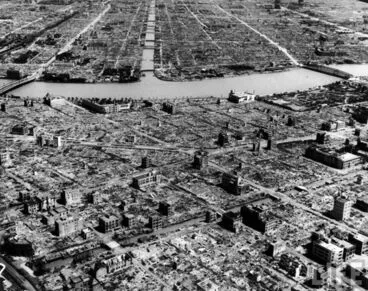

























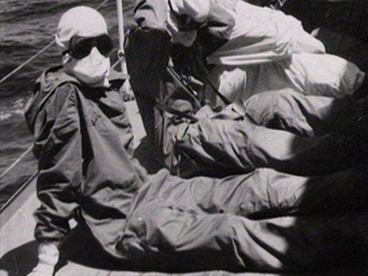
















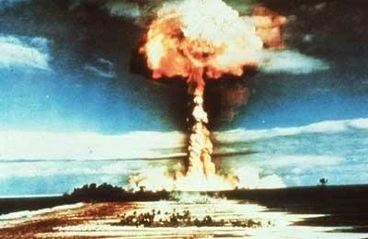





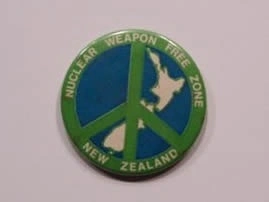
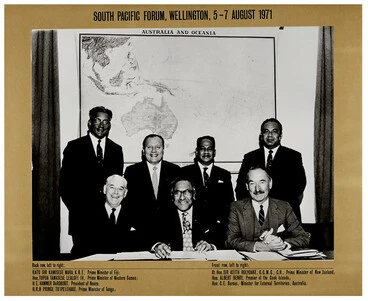


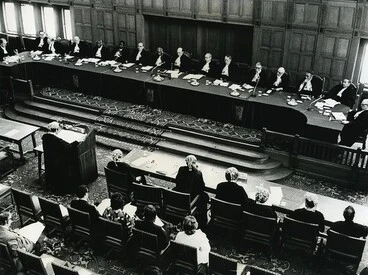



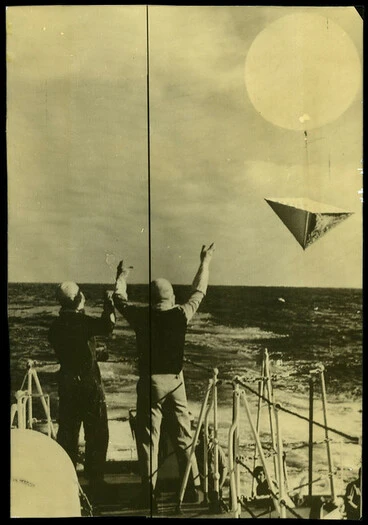
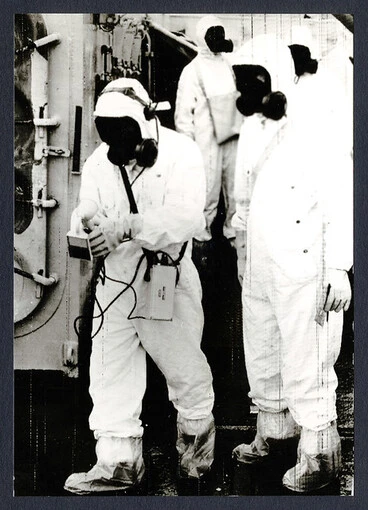
![Fri [ship] postcard Image: Fri [ship] postcard](https://thumbnailer.digitalnz.org/?resize=770x&src=https%3A%2F%2Fcollection.pukeariki.com%2Frecords%2Fimages%2Flarge%2F79288%2Fa77693606a2e8ee71e2004104b6a8c88261cd6f7.jpg&resize=368%253E)

